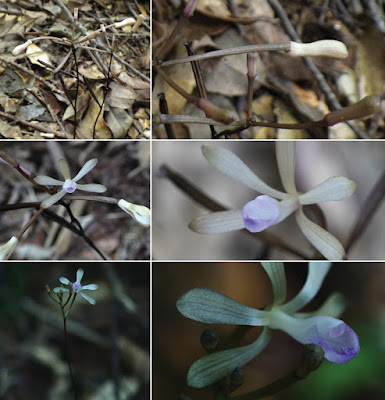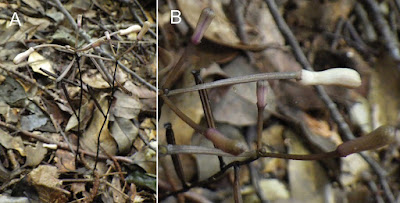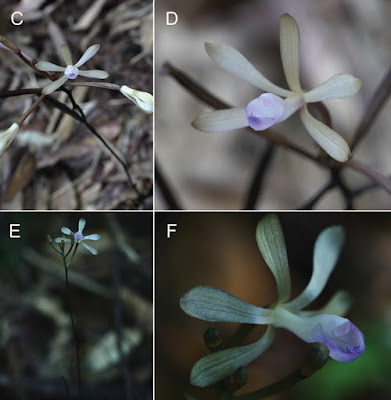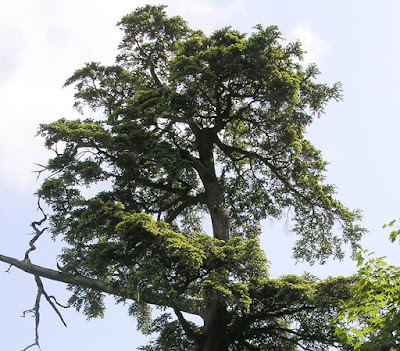[Most Recent Entries] [Calendar View]
Wednesday, January 10th, 2018
| Time | Event | ||||
| 11:05a | [Botany • 2018] The Taxonomic Identity of Three Varieties of Lecanorchis nigricans (Vanilleae, Vanilloideae, Orchidaceae) in Japan
Abstract To elucidate the taxonomy of the Lecanorchis nigricans Honda, 1931 species complex, the present study investigated the detailed morphology of three L. nigricans varieties in Japan. While L. nigricans var. patipetala Y.Sawa, 1980 and L. nigricans var. yakusimensis T.Hashim., 1990 have often been treated as synonyms of L. nigricans var. nigricans, the present study demonstrates that the three varieties are morphologically distinct. More specifically, L. nigricans var. nigricans only produces complete cleistogamous flowers and is distinct from the plants currently called “L. nigricans”, which are identical to the chasmogamous variety L. nigricans var. patipetala. The other chasmogamous variety L. nigricans var. yakusimensis can be easily distinguished from L. nigricans var. patipetala by its more spatulate tepals and higher cucullate lip. Therefore, the present study provides emended description of the three L. nigricans varieties based on type specimens and specimens collected from type localities. In addition, the isotype specimen of L. nigricans var. patipetala is designated as the lectotype because the holotype has been lost. Keywords: Japan, Lecanorchis nigricans var. yakusimensis, Lecanorchis nigricans var. patipetala, Lecanorchis taiwaniana, lectotypification, mycoheterotrophy, taxonomy
Taxonomic treatment Lecanorchis nigricans Honda emend. Suetsugu & Fukunaga Type: JAPAN, Wakayama Pref., Nishimuro County, Iwata, Oka, date unknown 1931, K. Kashiyama s.n. (holotype TI!; Isotype TI!). • Lecanorchis nigricans var. nigricans • Lecanorchis nigricans Honda var. patipetala Y.Sawa emend. Suetsugu & Fukunaga • Lecanorchis nigricans Honda var. yakusimensis T.Hashim. emend. Suetsugu & Fukunaga Kenji Suetsugu, Chie Shimaoka, Hirokazu Fukunaga and Shinichiro Sawa. 2018. The Taxonomic Identity of Three Varieties of Lecanorchis nigricans (Vanilleae, Vanilloideae, Orchidaceae) in Japan. PhytoKeys. 92: 17-35. DOI: 10.3897/phytokeys.92.21657 | ||||
| 11:11a | [Ichthyology • 2018] Trimma hamartium • A New Species of Trimma (Pisces; Gobiidae) from the South-West Islands of Palau, western Pacific Ocean
Abstract A new species of Trimma is described from South-West Islands of Palau. Trimma hamartium n. sp. lacks scales on the cheeks and opercle, has 8–9 scales in the predorsal midline, 17–19 pectoral-fin rays with 5–10 branched rays in the middle of the fin, an unbranched 5th pelvic-fin ray that is 51–64% the length of the 4th ray, 17–19 gill rakers on the outer surface of the first gill arch, an U-shaped interorbital trench with a narrow, slit-like postorbital trench ending at the last papilla in row p, and has 6 papillae in row c beneath the eye. When freshly collected, the species is very similar in appearance to T. preclarum, with which it is syntopic at three of the more northern islands of the South-West Islands. Keywords: Pisces, taxonomy, Western Pacific, coral reef gobies, COI gene Richard Winterbottom. 2018. A New Species of Trimma (Pisces; Gobiidae) from the South-West Islands of Palau, western Pacific Ocean. Zootaxa. 4370(2); 123–136. DOI: 10.11646/zootaxa.4370.2.2 | ||||
| 11:03p | [Botany • 2017] Tsuga ulleungensis • A New Species and Introgression in Eastern Asian Hemlocks (Pinaceae: Tsuga)
Abstract Species delimitation in Pinaceae is often challenged by limited morphological differentiation and introgression. In Tsuga (hemlocks), species delimitation has been most challenging among northeastern Asian taxa, where the species are weakly marked morphologically and range in number from three to five in previous studies. Two low-copy nuclear four-coumarase-ligase (4CL) genes andmorphology strongly support a clade of the Japanese endemic T. diversifolia and T. sieboldii from Japan and Ulleung island (Ulleungdo) in Korea. This clade is here referred to as the oceanic hemlocks. 4CL strongly supports a sister-group relationship of the widespread northeastern Asian T. chinensis and eastern North American T. caroliniana. In contrast, chloroplast genomes, which are markedly reduced in Tsuga and relatives, strongly support Japanese T. sieboldii as sister to T. chinensis and moderately support T. caroliniana as sister to a clade of T. diversifolia and hemlocks from Ulleungdo. These divergent topologies suggest chloroplast capture of T. chinensis by Japanese T. sieboldii. Ulleungdo hemlocks are distinct from other northeastern Asian species in leaf and cone morphology and phenologically in common-garden observations. We therefore describe these hemlocks as a new species, Tsuga ulleungensis. Keywords: Chloroplast capture, island endemic, plastid genomes, quantitative morphology, Ulleungdo Garth Holman, Peter Del Tredici, Nathan Havill, Nam Sook Lee, Richard Cronn, Kevin Cushman, Sarah Mathews, Linda Raubeson and Christopher S. Campbell. 2017. A New Species and Introgression in Eastern Asian Hemlocks (Pinaceae: Tsuga). Systematic Botany. 42(4); 1-15. DOI: 10.1600/036364417X696474 UMaine-led team discovers new hemlock species umaine.edu/news/blog/2017/12/28/umaine-l |
| << Previous Day |
2018/01/10 [Calendar] |
Next Day >> |








